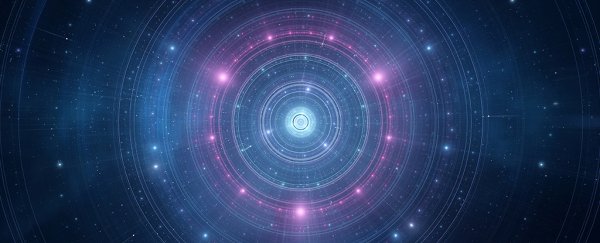Deep inside the diffuse haze of gas and dust that surround the smallest galaxies, dark matter could be clumping into cold droplets called 'Bose stars'.
Of course, we don't even know what the mysterious dark matter is, let alone have evidence of invisible 'stars'. But if current assumptions pan out, a new mathematical model suggests dark matter might have some strange interactions.
The model was proposed by a team of Russian physicists who considered the way hypothetical particles of dark matter might aggregate in the smallest of galactic halos.
"In our work, we simulated the motion of a quantum gas of light, gravitationally interacting dark matter particles," says physicist Dmitry Levkov from the Institute for Nuclear Research of the Russian Academy of Sciences.
Around 80 percent of the mass in the Universe is made of something we can't seem to detect. Whatever it is, it doesn't interact with normal matter through the usual channels, such as by exchanging photons via the electromagnetic field.
The only sign of its presence is the added oomph it adds to the clumping of galaxies. Still, that's no small thing – this unseen gravitational tax has already been mapped out in detail, providing us with key information on its nature.
Thanks to its clear affinity for galaxies, we can assume the speed of the stuff making up dark matter isn't fast enough to shoot off into the voids of space. It has to be relatively slow moving.
One candidate for this sluggish dark matter is a hypothetical particle called an axion. They're a type of boson – not unlike the photon – that was proposed as a solution for another perplexing paradox in quantum physics.
Another option is fuzzy dark matter. It's yet another type of boson, invented as a solution to a dilemma in astrophysics concerning the distribution of dark matter in galactic haloes.
Neither of these bespoke bosons have been shown to exist. But if at least one of them turned out to be real, under some circumstances they could do some interesting things.
The authors claim the model is the first to look at the kinetics of such a dark matter Bose-Einstein condensate actually forming.
Bose-Einstein condensates are the Anonymous rallies of quantum particles. When the temperature drops to just above absolute zero, particles quit mixing and lose their individual identities to look eerily the same.
Previous attempts have stuck to asking what happens when the bosons have already come together, such as in an infant Universe. In this case, they began with a jumble of interacting bosons.
"We started from a virialised state with maximal mixing, which is kind of opposite to the Bose-Einstein condensate," says Levkov.
"After a very long period, 100,000 times longer than the time needed for a particle to cross the simulation volume, the particles spontaneously formed a condensate, which immediately shaped itself into a spherical droplet, a Bose star, under the effect of gravity."
In effect, a cloud of 'dark' bosons becomes the same particle. Not only that, the physicists have worked out this cloud can pull together under gravitational effects to form a globe – a Bose 'star'.
The conditions for these hypothetical objects would need to be fairly specific, such as concentrated in the middle of the relatively small halo surrounding a dwarf galaxy. And even then, while it should take place within the lifetime of the Universe, it would still be a slow process.
These kinds of 'what if?' scenarios might sound a little sci-fi, but they help us improve boundaries on where to hunt for clues on this whole dark matter mystery.
"The next obvious step is to predict the number of the Bose stars in the Universe and calculate their mass in models with light dark matter," says Levkov.
One day we will finally have a grasp on the fundamental nature of this ghostly mass. When we do, we're almost certainly going to find some fascinating new structures hiding in plain view among the stars.
This research was published in Physical Review Letters.
